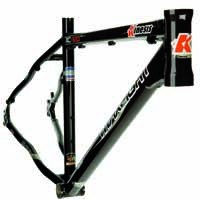Kinesis XC>120 £299
 Weight: 1,550g/Sizes: 42, 46, 50, 55cm
Weight: 1,550g/Sizes: 42, 46, 50, 55cm
Colours: Black, red, or mocha (shown)
Contact: www.kinesisbikes.co.uk
When Kinesis launched the original Maxlight XC in the early Noughties, 100mm of travel seemed the logical maximum you’d put on a hardtail; but times change, and in 2007 there are hardtails on the market designed around seven- and eight-inch travel forks (no, we wouldn’t buy one either) and 100mm-travel forks are the preserve of racers, newbies and Euros.
The Kinesis XC>120 develops the original XC frame but is based on what’s now a conservative 120mm fork. Own-brand Kinesis Kinesium alloy is used throughout the front triangle to produce a 46cm (18in) test frame that weighs 1,550g (3.5lb) on the office scales — light in anyone’s book. Almost every tube receives some form of manipulation, from hydroforming of the top and down tubes to increase stiffness, to curving of the seatstays to aid comfort; it all adds up to an up-to-the-minute design. One of the problems of adding a long fork to a hardtail is that it raises the front end; to counteract this, Kinesis has specced a ZeroStack head tube. The headset retains press-in cups, but they sit inside an oversized head tube, minimising stack height, increasing the weld area and meaning the frame isn’t doubling as the bearing seat.
Fixed 120mm travel forks are few and far between, so we set our test frame up with a 130mm travel Marzocchi XC600 fork, a 70mm Race Face stem and lightweight DT Swiss wheels with a 2.2in front and 2in rear tyre. This achieved a 71.5deg seat angle, 68.5deg head angle and 12.3in bottom bracket height. We feel these angles are about right for a bike of this nature, although we’d happily see an extra degree lopped off the head angle. This would mean you could run equal sized tyres front and rear with a 120mm fork the bike is designed for, without steepening the front end geometry too much. Fully built up, the bike weighed 24.4lb.
With the XC>120, we were looking for a bike that would excel on the sort of trail rides we love — steep, technical descents and fast fire-road climbs to get you back to the top of the hill in double-quick time for more singletrack. It took a while to get the position dialled, but with a 2.2in front tyre in place to slacken the head angle a touch, we’re just about there. At first we found the front end a little short and high for comfort. This shortness quickly proved an asset when the going got fast, flowy and/or steep, allowing us to quickly get over the back end or ride on the front fork, taking advantage of all the travel.
At £299, the XC>120 is good value. With a 130mm fork it can easily be set-up to compete with the best trail hardtails. But a couple of details have been overlooked to achieve the price point: there’s no seatpost clamp, the headset isn’t the sort every shop will stock and there are no bolts in the bottle cage bosses. We’d happily pay the extra to get these bits included.
MBR RATING: 8/10















